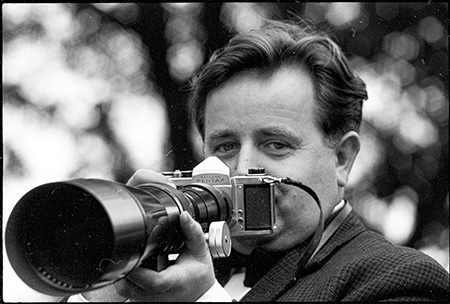In 1956, photojournalist John Sadovy won the OPC’s Robert Capa Gold Medal Award for his coverage of the Hungarian Revolution. Those photographs will be displayed at an exhibition later this month at the Hungarian National Museum. The following piece, written by his daughter, reflects on the personal and international importance of those images. Click here to see the exhibition page on the museum website.
by Yvonne Sadovy
Growing up in the 1950s and 1960s, photos taken by my father, John Sadovy, were a constant presence at home. Over time they gradually changed, shifting from black and white to color, from conflict and everyday life to celebrities, models and advertising. One small set of photos, however, remained the same, and I knew that it must be important: This small selection of images he took in Budapest in 1956 as events of the Hungarian Revolution unfolded. It was only many years later that I came to understand, in two very different ways, their relevance to both of us personally, as well as for global events that followed 1956.
In the 1990s, after John had suffered several strokes, he stopped taking photos and put to one side a project that he had been working on to compile a collection of his work since the 1950s. His photos were also a special part of my own life and so I decided to try to complete this project. I did not know much about his earlier work, his LIFE assignments in particular, and decided to reach out to family and colleagues to learn more. I was incredibly lucky that Tim Foote (1926-2015), the LIFE correspondent who had worked with John in two of his most important LIFE assignments – the uprisings in Oued Zem, Morocco, in 1955 and in Budapest in 1956 – generously shared many memories of their time together. He described to me how my father took his powerful photos and his remarkably calm style when working under stress.
My project to assemble John’s photos stayed on hold for several decades but was never forgotten, and sometimes I was reminded of it in unexpected ways. In 1993 I took up an academic post at the University of Hong Kong which kept me very busy; I was to stay there for almost 3 decades. But even in this city, so far from Europe and decades after 1956, I was to feel reverberations of Budapest. After Hong Kong’s failed “Umbrella”movement in 2013 and 2014, protests again erupted between 2019 and 2020 due to growing tensions over Chinese government influence. As frustrations grew, students became particularly active but the government ignored them and violence escalated. Mainland China eventually crushed the protests with the introduction, in June 2020, of a National Security Law that has effectively repressed the limited democracy there once was in the city. Many people were jailed or have fled; history is being rewritten, photographs reinterpreted. Parallels between Hong Kong and Budapest of 1956 became evident after classified accounts from 1956 were made accessible in the early 2000s. One previously unknown link, for me, was to discover that China’s perspective had been sought by the Soviets during the 1956 uprising. Initially non-committal, China eventually concurred with the Russian reinvasion of the Hungarian capital that ultimately crushed the revolution.
Even in 2023, there is much to learn from the visual heritage of the 1956 revolution. After the Hungarian uprising was crushed, the communist dictatorship hushed up and falsified the events of the revolution for decades. But, from 1989, the fall of the Berlin Wall and the end of communism in Hungary, research into this significant episode of 20th-century Hungarian history became much easier. One important outcome was the discovery of thousands of photographs taken by professional photographers, photojournalists, and amateurs between Oct. 23 and the beginning of Nov. 1956, including many of John’s that had not previously been published.
The Hungarian National Museum is at the forefront of exploring and presenting images of the revolution, and in the last three decades several foreign photojournalists’ photos from 1956 have been presented to the public. Most of the pictures of 36 Western photojournalists who visited Hungary during the days of the revolution have not yet been seen by the Hungarian and international public in exhibitions and books. The upcoming exhibition in Budapest from Oct. 20 to Dec. 10 this year, and its extensive catalogue, are the result of a cooperation between the Hungarian National Museum and the Committee of National Remembrance, with contributions from John’s family. They present the pictures of a photojournalist who came to Hungary on behalf of the American LIFE magazine, and whose pictures – taken in Budapest and extensively published in the press – helped to show the world what was happening, and brought him international recognition as the recipient of the Overseas Press Club’s Robert Capa Gold Medal Award for this work.
Czech-born John Sadovy took around seven hundred photographs during his short assignment in Hungary. His two daughters, I and my sister, Liza Jane Sadovy, have made available his films for research and exhibition. In 2016, the Hungarian Cultural Centre exhibited some images in Europe House in London. The upcoming joint exhibition in Budapest will give a comprehensive picture of John’s life and his work in Hungary in 1956.
In addition to the photojournalist’s world-famous images of Republic Square, we also present several shots, previously unseen in Hungary, that give a glimpse into the life of freedom fighters during the ceasefire between Russian incursions, and the world of Hungarians waiting in an Austrian refugee camp. John’s shocking and compassionate images bring the conditions of the determined struggle for freedom against the communist dictatorship and the Soviet occupation, the armed and unarmed participants of the struggle, closer to the people of the 21st Century.

